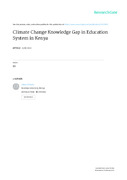| dc.description.abstract | Kenya, like other countries in the Horn of Africa, is severely affected by climate change. Droughts interposed with floods are recurrent climatic features particularly in the dry lands of the country. Climate extremes have not only led to low agricultural production but have also destroyed all other sectors of the economy such as tourism and industrialization rate. Droughts are the main contributing factor to high poverty levels having over 70% of the Kenya populace directly or indirectly depending on rainfed agriculture. Understanding of the climate issues is therefore crucial in averting any climate related risks. To realize economic development the government of Kenya has invested heavily on education, which is viewed as a central input in the development process. In Kenya’s Vision 2030, quality education as one of the priority sectors under the social pillar. Literacy level in Kenya stands to 87.5%. Unfortunately, the high literacy level has not translated to economic development as poverty levels stands at 47%. This study therefore sought to examine the climate change knowledge gap in the Kenya’s education system. Specifically, the study sought to establish the place of climate studies in the Kenya’s education system and also to establish the level of knowledge of climate change related issues among the Kenyan university students. The sample population included students from all university faculties in two public universities. A total of 108 students were sampled, 54 from each university. Almost all students (96.3%) were aware of changes in climatic patterns. In regard to the long rains (primary growing season in Kenya), 51.9% of the students observed reduction in rainfall events while 40.7 observed an increase. Rainfall amount was observed to be decreasing by 55.6% of the students. Increase in temperatures was observed by 70.4% and was attributed to increasing number of hot days. Despite the importance of climate change knowledge to the courses undertaken at the universities only 7.4% of the students wanted the climate change studies to be taught in universities. Majority (33.3%) of the students wanted the course to be taught at primary level only. The common mitigation strategy known by majority of the students was afforestation and reafforestation. The study identified two main factors that led to scanty knowledge of climate change: (i) negative attitude towards agriculture which was seen as the main sector affected by climate change and (ii) bias in the integration of climate science content in Kenya’s education system. To achieve the vision 2030 where education is aimed at enhancing both agricultural and industrial productivity, the study recommended an integration of climate science course in all subjects taught in schools, colleges and universities or introduction of climate change as a standalone subject at all levels of learning. | en_US |
